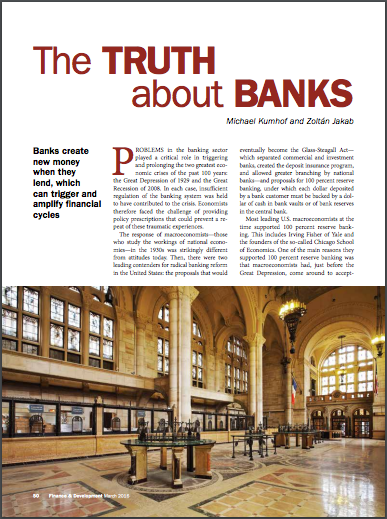IMF: The Truth about Banks


Banks create new money when they lend, which can trigger and amplify financial cycles, reads the article published on the International Monetary Fund’s website, written by Michael Kumhof and Zoltán Jakab.
Here are a few highlights:
“Most leading U.S. macroeconomists at the time supported 100 percent reserve banking.* This includes Irving Fisher of Yale and the founders of the so-called Chicago School of Economics. One of the main reasons they supported 100 percent reserve banking was that macroeconomists had, just before the Great Depression, come around to accepting some fundamental truths about the nature of banking that had previously eluded the profession, specifically the fact that banks fund new loans by creating new deposit money (Schumpeter, 1954). In other words, whenever a new loan is made to a customer, the loan is disbursed by creating a new deposit of the same amount as the loan, and in the name of the same customer. This was a critical vulnerability of financial systems, it was thought, for two reasons.
First, if banks are free to create new money when they make loans, this can—if banks misjudge the ability of their borrowers to repay—magnify the ability of banks to create financial boom-bust cycles. And second, it permanently ties the creation of money to debt creation, which can become problematic because excessive debt levels can trigger financial crises, a fact that has since been corroborated using modern statistical techniques (Schularick and Taylor, 2012).
The proposals for 100 percent reserve banking were therefore aimed at taking away the ability of banks to fund loans through money creation, while allowing separate depository and credit institutions to continue to fulfill all other traditional roles of banks. Depository institutions would compete to give customers access to an electronic payment system restricted to transactions in central-bank-issued currency (some of which could bear interest); credit institutions would compete to attract such currency and lend it out once they had accumulated enough.”
*Note:
The Positive Money proposals are often mentioned alongside the 100% reserve proposals. The Positive Money proposals do indeed have the same goal, that is: to stop banks creating money in the process of making loans (or buying assets). However, the method is different. Learn more here.
“…virtually all recent mainstream neoclassical economic research is based on the highly misleading “intermediation of loanable funds” description of banking, which dates to the 1950s and 1960s and back to the 19th century. We argue instead for the “financing through money creation” description, which is consistent with the 1930s view of economists associated with the Chicago School. These two views have radically different implications for a country’s macroeconomic response to financial and other shocks. This in turn has obvious relevance for key policy choices today.”
“In modern neoclassical intermediation of loanable funds theories, banks are seen as intermediating real savings. Lending, in this narrative, starts with banks collecting deposits of previously saved real resources (perishable consumer goods, consumer durables, machines and equipment, etc.) from savers and ends with the lending of those same real resources to borrowers. But such institutions simply do not exist in the real world. There are no loanable funds of real resources that bankers can collect and then lend out. Banks do of course collect checks or similar financial instruments, but because such instruments—to have any value—must be drawn on funds from elsewhere in the financial system, they cannot be deposits of new funds from outside the financial system. New funds are produced only with new bank loans (or when banks purchase additional financial or real assets), through book entries made by keystrokes on the banker’s keyboard at the time of disbursement. This means that the funds do not exist before the loan and that they are in the form of electronic entries—or, historically, paper ledger entries—rather than real resources.”
“The availability of savings of real resources does not constitute a limit to lending and deposit creation, nor does the availability of central bank reserves. Modern central banks pursue interest rate targets and must supply as many reserves as the banking system demands at those targets. This fact flies in the face of the still very popular deposit multiplier narrative of banking, which argues that banks make loans by repeatedly lending out an initial deposit of central bank reserves.”
“…banks are not intermediaries of real loanable funds, as is generally assumed in the mainstream neoclassical macroeconomics literature. Rather, they are providers of financing, through the creation of new monetary purchasing power for their borrowers. Understanding this distinction has important implications for a host of practical questions.”
“Many policy prescriptions aim to encourage physical investment by promoting saving, which is believed to finance investment. The problem with this idea is that saving does not finance investment, financing and money creation do. Bank financing of investment projects does not require prior saving, but the creation of new purchasing power so that investors can buy new plants and equipment. Once purchases have been made and sellers (or those farther down the chain of transactions) deposit the money, they become savers in the national accounts statistics, but this saving is an accounting consequence—not an economic cause—of lending and investment. To argue otherwise is to confuse the respective macroeconomic roles of real resources (saving) and debt-based money (financing).”
“The implication of these insights is that policy should place priority on an efficient financial system that identifies and finances worthwhile projects, rather than on measures that attempt to encourage saving, in the hope that it will finance desired investment. The “financing through money creation” approach makes it very clear that with financing of physical investment projects, saving will be the natural result.“
Read the whole article on IMF website or download a PDF here.